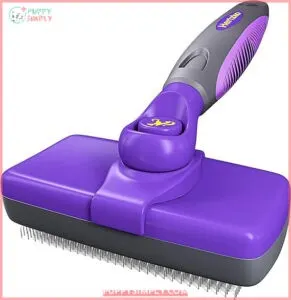This site is supported by our readers. We may earn a commission, at no cost to you, if you purchase through links.

The truth is, Huskies weren’t bred to swim. These Arctic athletes evolved to pull sleds across frozen tundra, not paddle through rivers. Their dense double coat, powerful legs, and lean build create a mixed bag regarding swimming—they can do it, but it doesn’t come as easily as it does for breeds like Retrievers.
Understanding your Husky’s unique relationship with water helps you introduce swimming safely, building confidence while respecting their natural hesitations and physical limitations.
Table Of Contents
- Key Takeaways
- Are Huskies Natural Swimmers?
- Physical Traits That Affect Husky Swimming
- Why Some Huskies Dislike Water
- Can Huskies Learn to Swim?
- Steps to Teach Your Husky to Swim
- Essential Safety Tips for Swimming Huskies
- Benefits and Risks of Swimming for Huskies
- Top 4 Products for Safe Husky Swimming
- Frequently Asked Questions (FAQs)
- Do Huskies like water?
- Can Huskies swim?
- Can a husky swim in cold weather?
- How to train a husky to swim?
- Can a husky swim too fast?
- Why do Huskies hate swimming?
- How does a husky’s double coat affect its ability to swim?
- How can I tell if my husky is enjoying swimming or if it is just tolerating it?
- How often should Huskies swim per week?
- Can swimming help Huskies lose weight effectively?
- Conclusion
Key Takeaways
- Huskies can swim, but they weren’t bred for it—their Arctic heritage focused on endurance running across ice, not paddling through water, which means their thick double coat becomes heavy when wet and their body structure requires more energy to stay afloat than natural water breeds.
- Early water exposure between 3-12 weeks is critical for building swim confidence, as 70-80% of dogs introduced during this window develop lasting comfort with water, while delayed or negative first experiences often create permanent anxiety that’s much harder to overcome in adulthood.
- Swimming offers real benefits like low-impact joint exercise and mental stimulation, but poses serious risks including hypothermia (below 98°F body temperature), exhaustion from their waterlogged coat, and drowning—making constant supervision, proper life jackets, and recognition of distress signals (frantic paddling, glazed eyes, coughing) absolutely essential.
- Training success depends on gradual introduction starting in shallow water, using positive reinforcement with treats and praise during short 5-10 minute sessions, and respecting your individual dog’s temperament since 30-40% show natural curiosity while 20-30% resist water completely.
Are Huskies Natural Swimmers?
When you picture a Husky, you probably think of snow-covered trails and sled teams, not poolside lounging. That’s because these dogs weren’t bred to paddle through water—they were built for a completely different environment.
Let’s look at what their history, instincts, and physical makeup tell us about their relationship with swimming.
Husky Origins and Swimming History
Understanding the Siberian roots of this ancient breed reveals why Huskies aren’t natural swimmers. Their evolutionary history spans over 9,500 years in Arctic habitat, where the nomadic lifestyle centered on frozen landscapes—not water.
Here’s what shaped the Husky breed characteristics:
- Bred by Siberian tribes for sled pulling across snow and ice
- Evolved in environments where swimming meant hypothermia risk
- Physical traits of Huskies optimized for endurance on land
- Natural abilities of Huskies focused on cold tolerance, not aquatic skills
- Canine aquatic behavior never became essential for survival
Their history explains everything about their relationship with water today. The Siberian Husky’s original purpose was for Arctic sled racing, which influenced their physical and behavioral development.
Instinctual Behaviors Around Water
When you observe Huskies and water introduction for the first time, you’ll notice canine reactions vary wildly. Some Huskies show immediate curiosity, while others freeze at the water’s edge—breed characteristics shaped by Arctic heritage.
Their canine aquatic behavior leans toward caution, not enthusiasm. Unlike breeds with strong water instincts, natural abilities of Huskies center on land-based endurance. Huskies’ swimming behavior reflects limited aquatic adaptation, making individual temperament key in predicting comfort levels.
Understanding their water preference traits is essential for a safe and enjoyable experience.
Comparison to Natural Water Breeds
Natural water breeds like Labrador Retrievers and Golden Retrievers put Huskies’ swimming ability in perspective. Breeding differences are obvious: Labs boast water-repellent coats and pronounced webbed feet, while Huskies weren’t designed for aquatic life.
Here’s what sets them apart:
- Swim stroke efficiency: Water breeds paddle powerfully with minimal fatigue
- Water resistance: Their coats dry quickly, unlike Huskies’ heavy double layers
- Canine adaptations: Breed comparisons reveal Labs’ natural buoyancy versus Huskies’ endurance-focused build
Understanding these differences guides realistic expectations for Husky water safety.
Physical Traits That Affect Husky Swimming
Your Husky’s body wasn’t exactly designed for life in the water, but that doesn’t mean swimming is off the table. Several physical traits work in their favor, while others create real challenges you’ll need to understand.
Let’s break down the key features that determine how well your Husky manages the water.
Double-layered Coat and Buoyancy
Your Husky’s double coat works like a two-edged sword in water. The waterproof outer layer and dense undercoat trap air, creating natural buoyancy that helps your dog float.
However, once fully soaked, that same thick fur becomes heavy and exhausting to manage. The coat’s thermal regulation keeps your Husky warm in cold water, but swimming efficiency drops as the wet weight accumulates.
Body Structure and Muscle Strength
Your Husky’s skeletal frame and muscle strength shape their swimming ability more than you’d think. Their medium build facilitates moderate buoyancy, but low body fat means less natural flotation compared to water breeds.
- Muscular legs provide strong propulsion but demand higher energy expenditure in water
- Swimming requires 50-70% more effort than running
- Strength training and muscle conditioning improve swimming efficiency by up to 7.5%
- Their double coat adds drag, increasing physical exertion during each stroke
Paws, Webbing, and Propulsion
Your Husky’s paws feature moderate webbing between the toes—less than water breeds but enough to boost propulsion by under 10%. This webbing increases surface area during paddling, helping them push water backward more effectively.
While their paw anatomy wasn’t designed for swimming like retrievers, it aids a decent dog-paddle technique. Think of it as functional rather than specialized for water.
Energy Levels and Endurance
Generally, Huskies possess outstanding aerobic capacity and muscle strength—they can run 60-100 miles daily during sled races. However, swimming demands greater energy expenditure than land-based physical exercise.
Their dense coat becomes waterlogged, increasing resistance and limiting swimming endurance compared to their superior running stamina. Physical conditioning and endurance training can improve Huskies’ swimming abilities, but expect shorter sessions than their usual canine aquatic exercise tolerance would suggest for physical activity.
Why Some Huskies Dislike Water
Not every Husky takes to water like a Lab or Retriever. Some will wade in without hesitation, while others act like you’ve asked them to walk through fire.
Understanding why your Husky might resist water helps you work with their instincts instead of against them.
Fear of Water and Negative Experiences
A single traumatic water experience can derail your Husky’s swimming journey completely. Studies show that 23% of Husky owners report negative incidents—like forced immersion or slipping—creating lasting aquatic anxiety.
One traumatic water incident can create permanent aquatic anxiety in your Husky—23% of owners report lasting fear from forced immersion or slips
Dogs with water phobia show stress behaviors including pacing and vocalizing in 68% of cases.
Early fear prevention matters: Huskies introduced to water before 12 weeks rarely develop these negative associations, while late exposure increases aversion risk markedly.
Discomfort With Being Wet
Ever notice your Husky bolts after a bath? That soggy, heavy sensation from their double coat isn’t just unpleasant—it’s genuinely distressing. The thick fur absorbs water like a sponge, creating cold stress and mobility issues that affect Huskies’ swimming behavior more than you’d think.
Here’s why wet coat issues trigger water sensitivity:
- Waterlogged fur weighs them down, reducing buoyancy and swimming comfort markedly
- Heat loss jumps 30-40% when wet, creating cold stress even in mild weather
- Drying takes hours, leaving them vulnerable and uncomfortable longer than short-coated breeds
- Matted, clinging fur restricts movement, making negative associations with water likely
- Sensory overload from wet faces and ears causes 60% of Huskies distress around water
Proper fur maintenance and gradual introduction of Huskies to water helps, but respect their discomfort—Huskies and water safety starts with understanding their unique coat challenges during their first water experience.
Influence of Early Exposure and Socialization
Your puppy’s first splash shapes their entire relationship with water. Research shows that 70-80% of dogs introduced to water during the critical 3-12 week socialization window develop lasting swim confidence. Without early water acclimation, fear prevention becomes harder—negative first experiences cement anxiety that teaching Huskies to swim later can’t easily undo.
| Timing | Puppy Socialization Impact | Adult Swimming Behavior |
|---|---|---|
| 3-12 weeks | Positive water introduction | High confidence, minimal fear |
| 12+ weeks | Delayed or forced exposure | Increased reluctance, stress |
| No exposure | Missed canine development window | Persistent water avoidance |
| Negative experience | Trauma during learning | Long-term aversion patterns |
| Gradual training | Patient, reward-based methods | Improved Huskies swimming ability |
Introducing Huskies to water early through play and treats builds trust. Husky training methods emphasizing patience create better swimmers—Huskies’ swimming behavior reflects those foundational experiences more than breed instinct alone.
Can Huskies Learn to Swim?
Yes, Huskies can absolutely learn to swim, though it won’t come as naturally as it does for breeds like Retrievers or Spaniels. Success depends heavily on your dog’s personality, early experiences with water, and your patience during training.
Let’s look at the key factors that determine whether your Husky will take to the water.
Individual Temperament and Willingness
Your Husky’s swimming ability hinges on temperament—about 30-40% show natural curiosity toward water, while 20-30% resist it completely. Huskies’ swimming behavior varies widely: confident dogs adapt faster, anxious ones need gentle socialization methods. Temperament testing helps predict success.
Owner influence matters; patient, reward-based teaching increases willingness by 50%. Teaching Huskies to swim works best when you match training to their individual personality and breed variations.
Importance of Early Water Introduction
Timing your Husky’s first water experience makes all the difference. Early exposure between 3 to 14 weeks shapes swim confidence and canine development for life. Puppies introduced during this critical window show stronger Huskies swimming abilities and fewer fear responses later.
Water socialization through puppy training builds trust—dogs that miss this opportunity often develop lasting anxiety around swimming, making Husky water introduction harder as adults.
Overcoming Reluctance With Training
Once your Husky shows interest, consistent training methods rooted in canine psychology transform reluctance into water confidence. Positive reinforcement in training—treats, praise, gentle encouragement—works better than force every time.
Effective swim coaching includes:
- Brief training sessions (5-10 minutes) to prevent overwhelm
- Gradual introduction to deeper water as comfort builds
- Rewarding calm Huskies swimming behavior immediately
- Respecting fear signals without pushing too hard
Patience unlocks their hidden swimming abilities.
Steps to Teach Your Husky to Swim
Teaching your Husky to swim doesn’t happen overnight, but with the right approach, most dogs can learn to enjoy the water. You’ll need patience, consistency, and a plan that respects your dog’s pace and comfort level.
Here are the key steps that will help your Husky become a confident swimmer.
Gradual Introduction to Water
Think of water acclimation like opening a door slowly—not kicking it down. Start your Husky’s swim training in calm environments where they can explore at their own pace.
Gentle exposure means letting them wet their paws first, then belly-deep wading, before attempting full swimming. This gradual introduction to their first water experience builds trust and prevents the fear that derails many dogs’ swimming journeys.
Using Positive Reinforcement
Rewards release your Husky’s swimming ability faster than you’d imagine. Positive reinforcement drives training efficiency up to 80%, making each session count. Studies show reward-based training reduces stress by 65% compared to negative methods—your dog stays relaxed and engaged.
Here’s what works:
- Treats immediately after brave water steps
- Enthusiastic verbal praise for calm behavior
- Clicker methods to mark exact successes
- Playtime as motivation between swimming attempts
This approach builds dog motivation through trust, not fear.
Starting in Shallow Water
Your best starting point? Calm, controlled environments like the shallow end of a pool or gently sloping lake edges. Shallow entry helps with water acclimation and allows your Husky to touch bottom—critical for canine buoyancy confidence.
Gentle exposure through brief sessions (under 10 minutes) builds trust without overwhelming them. This foundation protects Huskies’ swim potential while prioritizing pool safety and water safety from day one.
Building Confidence and Stamina
Stamina development doesn’t happen overnight—it’s a marathon, not a sprint. Short swimming lessons (just a few minutes initially) paired with consistent positive reinforcement prevent overexertion while your Husky develops swimming skills naturally.
- Gradual exposure to deeper water strengthens physical exercise tolerance without stress
- Structured training with toys and treats turns swimming training into confidence-boosting play
- Psychological benefits emerge as your Husky masters new challenges through patience
Swimming lessons demand slow, steady progress.
Essential Safety Tips for Swimming Huskies
Even if your Husky learns to love the water, swimming comes with real risks that you need to stay ahead of. Your dog’s thick coat, energy levels, and natural instincts can all work against them once they’re in deeper water.
Let’s cover the essential safety measures that’ll keep your adventure-loving Husky protected during every swim.
Supervision During Water Activities
Constant vigilance isn’t optional when your Husky enters water—approximately 5,000 family pets drown annually in backyard pools, often with someone nearby. Stay within arm’s reach during swimming, watch for frantic paddling or unusual silence, and put your phone away. Behavioral monitoring catches distress fast.
Emergency preparedness means knowing canine CPR and having your vet’s number ready, because water safety tips for Huskies demand active attention.
Importance of Life Jackets
Think of a life jacket as your Husky’s safety net—it provides buoyancy benefits that prevent exhaustion and drowning, even for strong swimmers. Visibility features like bright colors help you spot them fast, while breed suitability matters since Huskies aren’t naturally buoyant.
The market growth in dog life vests reflects rising awareness: psychological comfort increases when your dog feels secure, making water safety genuinely achievable.
Recognizing Signs of Distress
Your Husky can’t tell you when something’s wrong, so you need to watch for warning signs yourself. Respiratory Distress like coughing or wheezing signals trouble fast. Statistical Risks show roughly 5,000 pets drown yearly in pools—dog safety isn’t optional.
- Heavy panting, frantic paddling, or glazed eyes indicate exhaustion
- Behavioral Changes like sudden lethargy or restlessness after swimming
- Coughing up frothy liquid or difficulty breathing requires immediate action
- Delayed Symptoms can appear hours later—watch for persistent coughing
- Bluish gums (cyanosis) are Emergency Indicators demanding urgent vet care
Recognizing these signs prevents tragedies like hypothermia or cold water shock, and knowing canine CPR adds another layer of water safety protection.
Ensuring Safe Entry and Exit Points
After spotting distress signals, your next job is stopping accidents before they happen. Pool ramps and sturdy dog ladders give your Husky clear routes in and out—panic sets in fast when they can’t find an exit.
| Safety Feature | Purpose |
|---|---|
| Visual Markers (flags, plants) | Help orient dogs to exits |
| Fence Barriers | Prevent unsupervised access |
| Life Jackets | Aid buoyancy near entry points |
Training approaches using positive reinforcement teach your dog where exits are, building confidence through repetition.
Benefits and Risks of Swimming for Huskies
Swimming can be a major benefit for your Husky’s fitness and well-being, but it’s not without its risks. Understanding both sides helps you make smart choices about when and how to let your dog enjoy the water.
Let’s break down what swimming offers your Husky and what hazards you need to watch for.
Physical and Mental Health Benefits
Beyond the splash and play, aquatic exercise delivers real therapeutic value for your Husky. Swimming builds muscle strength through full-body resistance while protecting joint health—essential if your dog faces mobility issues.
The mental stimulation keeps boredom at bay, while stress relief comes naturally through rhythmic movement.
For weight management, the benefits of swimming for Huskies outshine many land-based activities, burning calories without punishing their frame.
Potential Hazards Like Hypothermia and Exhaustion
Cold water can drop your Husky’s body temperature below 98 degrees, triggering hypothermia symptoms like shivering, pale gums, and stumbling. Swimming fatigue paired with exhaustion makes everything worse—your dog’s reflexes slow, coordination falters, and drowning risk climbs. Water hazards multiply when algae blooms lurk or water intoxication strikes from swallowing too much during play.
Watch for these red flags during cold exposure:
- Uncontrolled shivering or sudden lethargy after swimming
- Dilated pupils, stiff muscles, or difficulty staying afloat
- Persistent coughing or blue-tinged gums hours later
How to Prevent Water-related Injuries
Prevention starts before your Husky touches water. Install pool barriers and train yourself in CPR—these simple moves cut drowning incidents by 95%.
Secure safe exits your dog can actually use, check water quality for toxins, and outfit your swimmer in a life jacket every time.
Swimming safety isn’t optional when hypothermia and water hazards wait in every puddle.
Top 4 Products for Safe Husky Swimming
Getting your Husky comfortable in the water takes more than just good intentions—you need the right gear to keep them safe and make the experience positive. From flotation devices to grooming tools that handle wet fur, having quality products on hand can prevent accidents and build confidence.
Here are four essentials that’ll help your Husky swim safely and enjoy their time in the water.
1. Outward Hound Dawson Dog Life Jacket
When you’re teaching your Husky to embrace the water, a reliable dog lifejacket becomes your safety anchor. The Outward Hound Dawson offers neoprene buoyancy panels that keep your dog afloat while adjustable straps guarantee a secure fit across various body shapes.
You’ll appreciate the dual rescue grips for quick retrieval and reflective visibility features for low-light conditions. Accurate sizing considerations matter—measure your Husky’s chest girth carefully, as proper fit determines effectiveness.
This lifejacket promotes dog water safety while building your companion’s confidence in unfamiliar aquatic territory.
2. FURminator Grooming Rake for Dogs Cats

After your Husky’s water adventures, proper grooming becomes essential—that’s where the FURminator Grooming Rake shines. This undercoat rake uses rotating metal teeth to remove up to 90% of loose fur, preventing those stubborn mats that trap moisture against your dog’s skin.
You’ll find the ergonomic handle gives you control during post-swim sessions, making it easier to work through your Husky’s dense double coat. Regular use promotes healthy skin while managing shedding effectively, though you’ll want to brush gently and follow your dog’s natural hair growth pattern.
3. Hertzko Self Cleaning Slicker Pet Brush

You’ll love the Hertzko Self Cleaning Slicker Brush for maintaining your Husky’s coat health between swimming sessions. This slicker brush removes up to 92% of loose fur and undercoat, with angled bristles that detangle without scratching skin.
The self-cleaning feature retracts bristles with one button press, making grooming convenience a reality—you’ll clear collected hair in under 10 seconds. With 4.3-star user satisfaction across thousands of reviews, it’s no wonder professional groomers trust this tool.
The ergonomic handle reduces wrist fatigue during those thorough post-swim brushing sessions your water-loving Husky needs.
4. Husky Puppy Training The Ultimate Guide

Training a husky puppy properly from the start makes all water-related activities safer down the road. Early socialization between 3-14 weeks shapes your puppy’s confidence around new environments, including water.
This digital guide covers obedience commands, crate training, and behavioral challenges specific to your breed—critical foundations before introducing swimming. You’ll find practical husky puppy care strategies using positive reinforcement, helping you build a training plan that tackles stubbornness while strengthening your bond.
At $4.99, it’s an essential first step in thorough puppy training.
Frequently Asked Questions (FAQs)
Do Huskies like water?
Picture your Husky bolting away from the hose—typical behavior. Most Huskies show water aversion, disliking bath time and swimming. However, individual preferences vary; some enjoy playful splashing or cooling strategies after positive early exposure.
Can Huskies swim?
Yes, they can paddle and stay afloat, but swimming abilities vary widely among individual Huskies. Breed characteristics, early water exposure, and training impact their confidence and skill in the water.
Can a husky swim in cold weather?
Like tossing a polar bear into a sauna, cold-water swimming contradicts your Husky’s arctic design. They can swim in cold weather, but hypothermia risks spike below 10°C.
Limit swimming duration, monitor for cold-water shock, and guarantee thorough coat drying afterward.
How to train a husky to swim?
Start with shallow water and positive reinforcement. Build your husky’s confidence gradually through short training sessions.
Use a safety plan with life jackets, supervise closely, and develop swimming skills through patient, consistent practice.
Can a husky swim too fast?
Huskies can experience swimming fatigue and hypothermia risk when moving too quickly through water. Their heavy coat increases drag, raising joint stress.
Watch for speed limits in strong water currents to help your dog swim safely.
Why do Huskies hate swimming?
Most water aversion causes stem from negative associations—bath time stress, instinctual discomfort with wetness, and their breed grooming habits. Coat drying issues magnify discomfort.
Early socialization gaps often create factors influencing Huskys’ swimming preferences throughout life.
How does a husky’s double coat affect its ability to swim?
Your husky dives into a lake—then struggles. That double coat acts like a sponge, absorbing water and weighing them down. Coat water retention reduces buoyancy and swimming stamina, especially in cold water temperatures.
How can I tell if my husky is enjoying swimming or if it is just tolerating it?
Watch your dog’s body language closely. Signs of enjoyment include enthusiastic water approaches, tail wagging, and playful splashing.
Discomfort indicators like heavy panting, reluctance to re-enter, or stiff movements suggest they’re just tolerating swimming safely.
How often should Huskies swim per week?
For healthy adults, aim for 2–3 swimming sessions per week, with each lasting 10–20 minutes. Puppies and seniors benefit from less frequent swims—once every 7–10 days—to prevent overexertion and support recovery.
Can swimming help Huskies lose weight effectively?
Low effort, high results—that’s the swimming paradox. Your dog’s body composition improves faster than running because calorie expenditure doubles while joint impact vanishes.
Mental benefits emerge alongside muscle, making aquatic exercise remarkably effective for weight management in Huskies.
Conclusion
Your Husky won’t transform into a dolphin overnight, but with patience and the right approach, they can learn to enjoy the water safely. Respecting their comfort level matters most, whether yours takes to swimming like a natural or needs encouragement every step of the way.
Can huskies swim? Absolutely—but success depends on gradual introductions, proper safety gear, and understanding that not every Arctic athlete needs to love the lake. Let them lead the pace.
- https://wpvet.com/pdfs/dogbreedinfo/winterparkveterinaryhospitalsiberianhusky.pdf
- https://www.sciencedirect.com/topics/veterinary-science-and-veterinary-medicine/habenula
- https://www.ncbi.nlm.nih.gov/pmc/articles/PMC3481573
- https://www.yahoo.com/lifestyle/siberian-husky-proves-swimming-prowess-150500961.html
- https://en.wikipedia.org/wiki/Siberian_Husky















